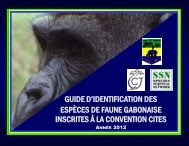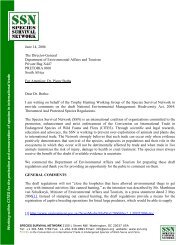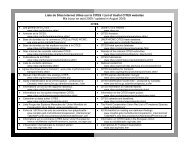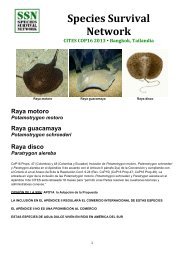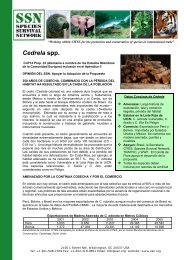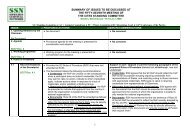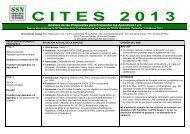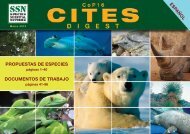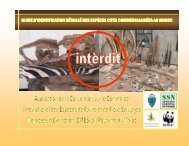CITES CoP16 Digest - Species Survival Network
CITES CoP16 Digest - Species Survival Network
CITES CoP16 Digest - Species Survival Network
You also want an ePaper? Increase the reach of your titles
YUMPU automatically turns print PDFs into web optimized ePapers that Google loves.
DOCUMENT BACKGROUND / CURRENT STATUS EFFECT OF DOCUMENT SSN VIEW<br />
56. Saiga antelope<br />
Cop16 Doc. 56<br />
• Critically Endangered saiga antelope (Saiga tatarica)<br />
(IUCN 2012) is found in Kazakhstan, Mongolia, Russia,<br />
Turkmenistan, Uzbekistan and is reported to be extinct<br />
in China, Moldova, Poland, Ukraine. It is threatened by<br />
uncontrolled illegal hunting for horns for traditional<br />
Chinese medicine trade; heavily skewed sex ratios<br />
due to hunting have caused population declines.<br />
• Six Decisions currently relate to trade in and conservation<br />
of saiga (14.91; 14.93 (Rev. CoP15); 14.94<br />
(Rev. CoP15); 14.95 (Rev. CoP15); 14.96 and 14.97<br />
(Rev. CoP15)).<br />
• Decision 14.94 (Rev. CoP15) encourages trading and<br />
consumer states to develop coherent policies and<br />
procedures for disposal of confiscated saiga parts and<br />
derivatives and for registration, marking and monitoring<br />
of saiga horn stockpiles.<br />
• Provides an update on actions taken.<br />
• Kazakhstan (largest population) reported poaching<br />
has increased significantly across all populations<br />
since 2010.<br />
• Proposes replacing current Decisions with others that,<br />
inter alia, directs<br />
• range, trading and consumer States to implement<br />
the Medium-Term International Work Programme<br />
for the Saiga Antelope (2011-2015) (MTIWP);<br />
• trading and consumer countries to reduce consumption<br />
in saiga products and derivatives;<br />
• Secretariat to report and, as necessary, make recommendations<br />
to SC regarding implementation of<br />
MTIWP; and<br />
• SC to consider reports from the Secretariat and<br />
make recommendations to CoP17.<br />
SUPPORT IN PART / OPPOSE IN PART<br />
• While SSN supports Decisions proposed, SSN strongly<br />
opposes deleting Decision 14.94 (Rev. CoP15); its recommendations<br />
should be maintained but are not contained<br />
in the MTIWP or proposed new Decisions.<br />
• SSN is concerned that, according to Doc. 56 (para 32),<br />
the Secretariat encouraged Mongolia to sell 2,000 seized<br />
saiga horns to “fund <strong>CITES</strong>-related conservation projects”.<br />
Given the Critically Endangered status of the species<br />
and current levels of poaching, SSN considers this<br />
to be entirely inappropriate. SSN encourages Parties to<br />
instruct the Secretariat to recommend that any Party in<br />
possession of seized siaga products destroy them.<br />
• SSN notes that this species qualifies for Appendix I.<br />
57. Snake trade and<br />
conservation<br />
management<br />
Cop16 Doc. 57<br />
• Decision 15.77 directs SC to make recommendations<br />
in response to AC recommendations regarding a technical<br />
workshop on trade and conservation of snakes<br />
in Asia held in China, April 2011.<br />
• Prepared by Chair of SC WG on snake trade and conservation<br />
management.<br />
• Proposes that CoP adopt Decisions that, inter alia:<br />
• direct Secretariat to compile information on making<br />
NDFs for snake species, and oversee studies<br />
regarding production systems for listed Asian<br />
snake spp. to differentiate wild from captive-bred<br />
specimens, and a study of one or more high-value<br />
snake species in pet trade;<br />
• direct AC to consider results of other studies on<br />
snake trade and develop recommendations for SC;<br />
• direct SC to consider these studies, AC results, and<br />
make recommendations to CoP17; and<br />
• direct Asian Parties to report to SC65 on their<br />
efforts to eliminate illegal and unreported trade in<br />
these species.<br />
SUPPORT<br />
• SSN is concerned about the large-scale mislabeling of<br />
wild-caught snakes as “captive-bred” for the international<br />
pet trade and the extremely high numbers of wild snakes<br />
collected for the international skin trade. SSN urges Parties<br />
to adopt proposed draft Decisions which will assist in better<br />
monitoring and reduce trade to a sustainable level.<br />
• SSN also urges Parties to adopt a Decision implementing<br />
the following AC recommendation in response to the<br />
workshop: “The AC should review the output of the IUCN<br />
Red Listing process for Asian snakes and make recommendations...<br />
for the consideration of the Parties with<br />
regard to amending the <strong>CITES</strong> Appendices” (SC61 Doc.<br />
46.2 (Rev. 1) Annex). The results would not require Parties<br />
to submit proposals but merely provide guidance as to<br />
which species may meet the criteria for listing. Such an<br />
effort also would support RC 14.2 on <strong>CITES</strong> Strategic<br />
Vision: 2008-2013, Objective 1.4, “The Appendices correctly<br />
reflect the conservation needs of species”.<br />
www.ssn.org<br />
77



